
Occupy Wall Street protesters have opted for tents as temporary shelter in Zuccotti Park in Manhattan. We looked at some other options for emergencies around the world. Photo by David Shankbone/Flickr
Occupy Wall Street protesters around the world and refugees escaping drought in the Horn of Africa have one thing in common: Tents. The protesters have opted for tents and plastic tarps to keep the rain off while they occupy parks in the developed world’s major cities, and the UN and charities such as ShelterBox are propping up tents for the nearly 2 million refugees in the world’s largest humanitarian crisis today.
Protesters in the developed world notwithstanding, more than 43 million people have been forcibly displaced from their homes, ousted by political violence or natural disasters, the UN High Commission for Refugees reports. Considering their plight, we wondered if tents are the best shelter option. To find out, we fielded comments from facebook, LinkedIn groups, our friends at Better World by Design and our members for insight into good shelter design. These are design tips and ten recommended emergency shelter designs.
Options: from plastic to prefab
Emergency shelter can be as simple as plastic sheeting over a frame of sticks, or as sophisticated as container homes that ship with solar power generators, refrigerators and other amenities. There are some amazing, though always cost-effective, things in prefab. Better than a few fifth-story walk-ups that some of us have lived in.
Design parameters
Shelter design should account for cost, finding where quality and quantity meet to best suit the conditions in each situation, UN Habitat explains in this report on emergency shelter projects worldwide. Provide a minimum of 3.5 meters of living space for each person. Consider the difficulty of the build and the logistics of training people to construct their shelter. The UN report found that designing shelters was easier than planning their distribution, set-up and administration. In fact, in some cases, the writers suggest leaving the design to the people who will live there, and providing adequate guidance and materials. Shipping and storage matter: Magic words here are “local materials” and “flat pack.” The degree of permanence might also make a difference in the design decision: compressed-earth blocks, adobe, and Cal-Earth’s sandbag and cement homes take more time to build than stringing up a plastic sheet, but they are cheap and could last for years. A few more things to consider: accessibility for the disabled and features such as power generation and refrigeration for preserving medication.
Earthen shelters
Adobe, compressed-earth blocks and sandbag shelters offer the possibility of permanent and even beautiful housing in an emergency situation. They are made from dirt, for the most part, so they’re cheap. Their drawbacks are that they require know-how and time to build.
Jim Hallock, a friend and member of E4C, offers workshops in earthen construction through hisInstituto Tierra y Cal. Calearth has a sandbag shelter solution and offers this online construction guide (pdf).
ECO:Shield
Chris Watkins, a co-founder of Appropedia and a self-described obsessive editor at the site, offered several shelter ideas on facebook. First, he suggests the ECO:Shield Global Housing Solution. The shelter is made from fiber-reinforced thermoplastic that ships flat and assembles easily with unskilled labor in 15 minutes. It weathers well, it’s energy efficient and could become permanent housing.
Hexayurts
Watkins also suggests the hexayurt. There is a movement around the hexayurt that has a home online at hexayurt.com. Fans build these structures at Burning Man as a geometrical addition to the temporary city that assembles every year in the Black Rock Desert of Nevada. Hexayurts don’t have to be temporary, however. Properly built, they could last for years. They can cost less than emergency housing tents and people can build them from local materials. A 15-square meter hexayurt built with plywood costs about $100. Construction guides and demonstration videos are available online.
Shipping container homes
Anna-Maria Sviatko posted a tip on facebook about shipping container homes. We turned to Sean Godsell’s Future Shack design for mass-produced emergency housing made from recycled shipping containers. The home ships with solar panels, water tanks, access ramp and lighting fixtures. Containers are poorly insulated and can become ovens in the sun, especially in hot climates. The double roof in Godsell’s design tries to offset that and shade the living space. Plus, the shelter sets up in uneven terrain with telescoping legs to level it. There are dozens of other examples of beautiful container homes pictured at fabprefab.
Shigeru Ban’s paper tubes
Helen Wheeldon posted a tip on facebook that reminded us about the Japanese architect Shigeru Ban’s paper tube housing. Ban has designed elegant homes with complex geometries from paper tubes, and he has also designed simpler emergency shelters and oversaw their deployment in disaster relief camps worldwide. Paper tubes can frame family-sized tents for temporary shelter, and they can build cabins for long-term housing.
Plastic sheeting
Everyone from the Occupy Wall Street crowds to hunters caught in a rainstorm have strung up plastic sheeting for shelter. They are the simplest emergency shelter designs, and two of our favorite sites provide how-to guides for building them. Appropedia links to an extensive guide here, and Instructables gives us this (predictably) odd tutorial on building an emergency shelter from sticks, plastic sheets and shoelaces.
Decadome
Decadome is one of two interesting emergency shelters featured at this year’s Better World by Design event at Brown University and Rhode Island School of Design. These are a series of shelters built from identical, lightweight decagonal panels. With a ladder and screwdriver, two people can assemble a home in about an hour.
Quadror
Quadror, also on display at BWxD, is, at its heart, a bunch of well-angled joints that hold poles in place. The poles can be manufactured from any construction materials or even scavenged from a nearby forest. Because it can rely so heavily on locally available materials, the system ships and stores well. The shelters can be permanent, and with no fixed building design or size, Quadror is adaptable to most situations.
CarterWilliamson’s emergency shelter
Matthew O’Hearn at the Australian architectural firm Carter Williamson http://www.carterwilliamson.com/ responded to our query on Engineers Australia’s LinkedIn group that the firm has an emergency shelter concept two years in the making. It has capacity for eight to 10 people on two floors, the pieces ship flat and two people can assemble it in one day. One of the interesting aspects of the design is that you can build it from found materials. For example, the firm’s rendering of a finished version shows a road sign as one of the wall panels.
“We think ours in not only interesting, but clever in its ‘simplicity’ in build, design and erection,” Shaun Carter, a principal at the firm, told E4C. Carter’s team is building the first prototype now.
Partner Aid International’s shelter
Larry Bentley, a lead consulting engineer at Verizon, saw our query on Engineers Without Borders-USA’s LinkedIn group and responded with a tip on this steel shelter. Partner Aid International developed the design and deployed these shelters to help victims of Pakistan’s earthquake in 2005 and 2006. They are made from locally available materials and can be adapted into permanent structures.
Know of other good designs? Let us know in the comments below!
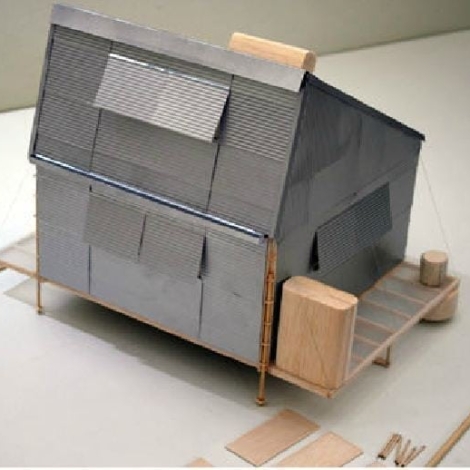
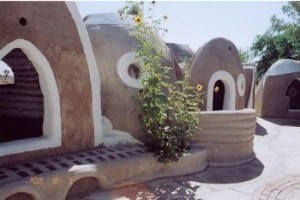
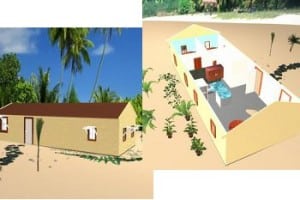
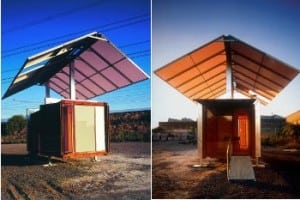
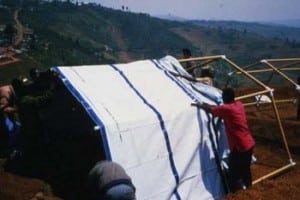

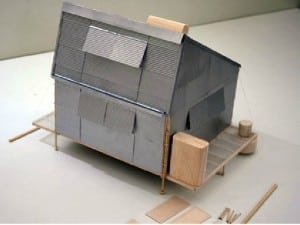
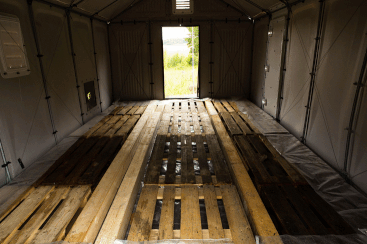
lol tx
gregapproves
gregapproves
the ALMIGHTY susan approves (that’s me)
The 16′ diameter and under yurt is a good shelter. Larger are not cost effective.
The round deck is easily framed in day or day half, and yurt goes up short day.
The 16′ provides 200 sq ft of space. They have excellent resale once things improve.
Pacific Yurts is a good product. Once persons impacted by disaster, moves on, easy to
sell on Craig’s list. lot of options re windows, etc.
I am comfortable in mine on my remote farm. Once I build I thought I might sell it,
but now have thoughts of guest house or ag prep room. Round is nice space.
I was intrigued by all the solutions presented. What about some lightweight foam concrete
structures? ferro cement was interesting concept in past. Now they have lightweight foams,
including some from soy base, inert, won’t burn like urethane foam. spray over reusable form.